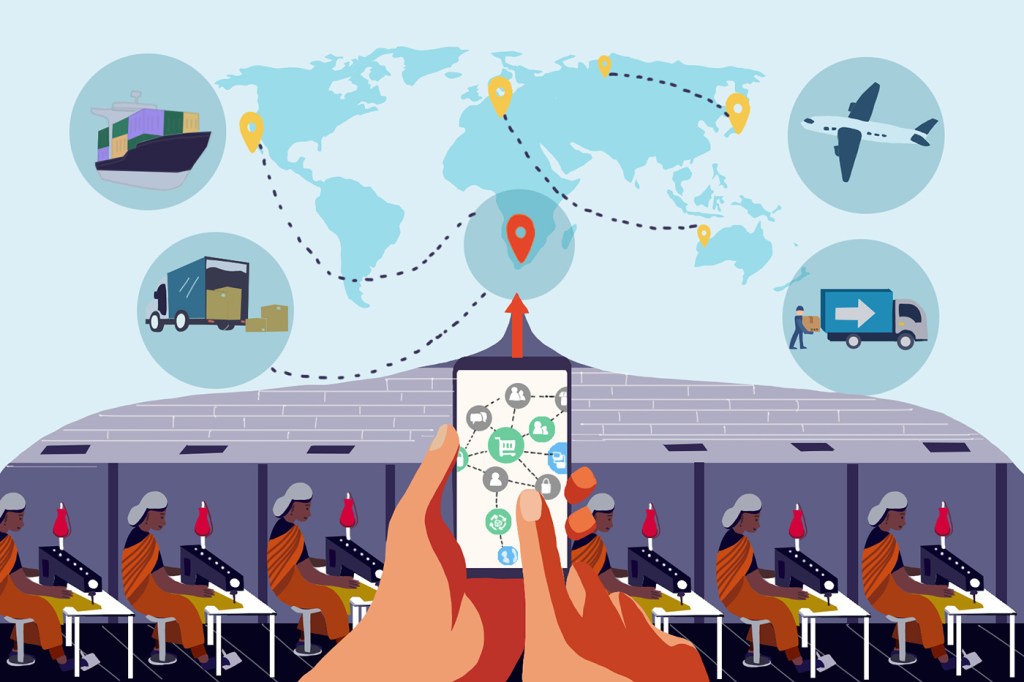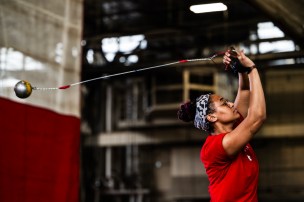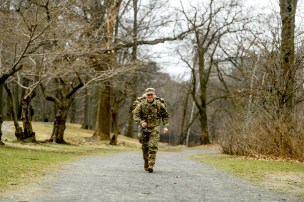Published on
Forced labor in the clothing industry is rampant and hidden. This AI-powered search platform can expose it.
Developed by Northeastern University researchers, Supply Trace combines machine learning and on-the-ground investigation to track goods from apparel companies to regions with a high risk of forced labor.

Almost all of the clothing sold in America comes from overseas, making a long journey on a shipping container into a domestic port. Peer inside any apparel shipment bound for customs checkpoints, groaning with t-shirts or leggings or underwear, and you’ll probably see tags hinting at their origins: Made in Vietnam, China, Indonesia. If you think about it any further, you may suppose that they took a straightforward journey from a factory in that country, eventually reaching the shelves of a store or e-retail warehouse and going into a shopping basket.
It’s more complicated than that. In fact, there’s a very good chance even the company selling those t-shirts and leggings doesn’t have all the information about where they really came from.
That mystery is emblematic of what has long been a frustratingly obscure, dangerous corner of the economy, plagued by human rights violations. The global apparel industry is worth about $1.7 trillion annually. According to watchdog groups, an estimated $161 billion worth of apparel and textile goods are at risk of being produced with forced labor — what human rights activists equate to modern-day slavery. An estimated 27 million people — the population of Australia — are trapped in forced labor across the globe.
And unwieldy journeys from manufacturing regions to consumers in countries that buy their goods make it easy for unscrupulous governments and factories to cover their tracks. “There’s no way for people to know where their products come from,” says Shawn Bhimani, an assistant professor of supply chain management at Northeastern University.
Bhimani and his colleagues are about to change that.
On Thursday, Bhimani and project director Katie Shaw launched Supply Trace [supplytrace.org], an open-access platform that combines machine learning with on-the-ground research to sniff out risks of forced labor in the global apparel supply chain. Meant primarily for industry use, the searchable database allows users to chart the path of apparel goods around the world, connecting hundreds of millions of data points on imports in purchasing countries with in-person reports detailing the locations and practices of facilities that use forced labor.
There’s no way for people to know where their products come from. We’re trying to create a level of transparency that should have always existed.
Shawn Bhimani, Northeastern University assistant professor of supply chain management
Users who search for a specific company on the platform will call up an auto-generated world map with color-coded lines indicating the likelihood that its goods have ties to areas of the world known to use forced labor, along with supporting documents compiled by the project’s facility investigation team at Sheffield Hallam University in the United Kingdom. In its pilot iteration, the target users are professionals within and around the apparel industry: fashion companies, human rights nonprofits and policymakers.
“We’re trying to create a level of transparency that should have always existed,” Bhimani says.
Initially, Supply Trace will be focused on cotton tracked back to the Uyghur region in Western China, a hotbed of forced labor thanks to oppressive government policies against the vulnerable Uyghur ethnic minority in that region. The Sheffield Hallam research team includes Uyghur nationals, some of whom work anonymously to protect their sources and families. But supply chain experts think the model will be a broad-based game-changer, shining a light on how goods of every stripe are sourced across the global supply chain.
“This has the potential to turn into something huge,” says Nada Sanders, a distinguished professor of supply chain management at Northeastern’s D’Amore McKim School of Business. “I would like this to grow across industries and regions.”
What we don’t know
One of the more surprising things about Supply Trace is that the information the platform can uncover was all but impossible to get previously. Under United Nations guidance, “forced labor” entails work compelled under threat of physical violence, fraud, withholding information or extortion of loved ones for another’s financial benefit. Importing goods made with forced labor has been illegal in the United States since 1930; for nearly a century, many Western countries have gradually adopted more specific regulations, banning imports from certain regions and levying fines on companies found to be out of compliance. In 2021, the U.S. Congress passed the Uyghur Forced Labor Prevention Act, banning imports from the region in Western China.
Yet at the same time regulations are addressing forced labor more directly, market pressures are making the problem worse. “Fast fashion” — the business model of producing garments in bulk as cheaply as possible, exemplified by discount retailers like Shein and Temu — has exploded in recent years, ramping up demand for supercheap apparel churned out at a breakneck pace.
“I’m not trying to pick on anybody, but if you think about it realistically, how is it possible to get a shirt or a pair of jeans to a customer so quickly for a few dollars?” Sanders asks. “Someone is not getting paid along the way.”
NGN Magazine, in your inbox.
Sign up to receive thoughtful stories that chronicle innovations and examine inspiring solutions to global problems.

For its initial launch, Supply Trace is focused on goods originating in Western China, where the government, per policy, is detaining, re-educating and forcibly working members of the Uyghur ethnic minority in textile mills and other industries. (The Chinese government denies this, but it is widely acknowledged by the international community).
The problem: cotton doesn’t go directly from the source to a merchant in the United States. It might travel to a supplier in another region, then to another country or two without import bans before eventually getting to a U.S. port. Not all of this movement is nefarious. “Sometimes products go from between one or two countries before they come to the U.S. because one country is better at harvesting cotton and another is better at sewing and dying it,” Bhimani says. “But it makes things complex.”
“In a supply chain, you have a ‘direct supplier,”’ but your direct supplier has a supplier, which has a supplier,” he explains. “By the time it’s three levels away from you, you have no idea who they are.”
Tracking down those “indirect suppliers” takes painstaking tracking of individual shipments, and the sourcing data that exists at a high cost. A few private platforms charge high fees for supply chain information — up to $50,000 per month. “That means over 99% of the world can’t access this,” Bhimani says. “We’re the first platform that will make it accessible for everyone.”
Charting a path
The base dataset for Supply Trace is U.S. imports — 400 million dating back to 2013. At Sheffield Hallam, a small group of researchers has contributed in-depth reports on facilities that use forced labor in Western China, drawing on clues from public records and state-run media.
“There are terms and policy wordings we look for,” says M. Tanrikut, a researcher at Sheffield Hallam and a Uyhgur national whose family has experienced forced labor. “There are euphemistic terms — ‘elevation programs’ is one, and ‘land transfer’ — with very horrible things happening behind them.”
“Obviously it’s not going to be as simple as finding an article that says ‘forced labor is used here,’ Shaw adds. “They’re looking at publicly available resources, then they start drilling down: where is this physically located? Oh, it’s really close to a prison. Or, there’s a type of language the Chinese media will use to people within the country, a kind celebration of great productivity. That’s a red flag.”
Machine learning enables Supply Trace to corral millions of those unwieldy data points and draw connections between them, spotting patterns at a scale that individuals cannot. “An algorithm can pick up correlations that might not be obvious to me and you,” Sanders says.
Bhimani breaks it down: “Let’s say for example, you are a small fashion company in Boston, and you think you have no exposure to China. You buy products from Indonesia, so the first [data point] machine learning picks up is an import record: who shipped it to you from Indonesia? What was their company name and address?
From there, where did it come from before it got to Indonesia? Indonesia has its own import records that might send you back to maybe Sri Lanka or India. And then eventually we trace it back to where the original content came from.”
At launch, the Supply Trace platform has traced more than 1 million companies, nearly 2 million relationships and over 2.5 million transactions using this combination of data.
“We can’t do this for every product,” Bhimani cautions. “But in this pilot, we’re working toward [flagging] areas of the world [from which] it is illegal to buy cotton.”
‘They want help’
Forced labor in the apparel industry has been a known problem in international watchdog circles for years; major retailers including Zara, Nike and Shein have come under recent scrutiny for the alleged presence of materials from the Uyghur region in their supply chains. But Bhimani and Shaw stress that Supply Trace isn’t about pointing fingers. “The platform uses specific phrasing around potential risk,” Bhimani says. “It doesn’t say, ‘X company is using forced labor.’ I hope companies and governments can take this as a starting point to go fix something that’s wrong.”
That small fashion company in Boston, for instance, could shift to an Indonesian supplier without risk exposure to the Uyghur region. Armed with better data, too, legislators and regulators will be better able to target policies. In focus groups with fashion companies and government officials, the feedback has been enthusiastic. “They can’t do this themselves, and they want some help,” Bhimani says. After the pilot phase, Bhimani and Shaw hope to expand Supply Trace to shine a light on other industries and more parts of the world. Sanders hopes the model eventually will give users the ability to track any product from the source to its consumer — from apparel to electronics and batteries. “I see this growing into something really powerful,” she says.
Schuyler Velasco is a Northeastern Global News Magazine senior writer. Email her at s.velasco@northeastern.edu. Follow her on X/Twitter @Schuyler_V.









